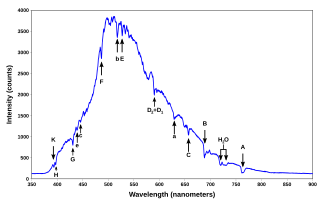
Back Spektraallyn Afrikaans خط طيفي Arabic Спектрална линия Bulgarian བསྡུ་ཐིག Tibetan Línia espectral Catalan Spektrální čára Czech Спектр йĕрĕ CV Spektrallinie German Spektra linio Esperanto Línea espectral Spanish
Absorption spectrum with Absorption lines (discrete spectrum)

A spectral line is a weaker or stronger region in an otherwise uniform and continuous spectrum. It may result from emission or absorption of light in a narrow frequency range, compared with the nearby frequencies. Spectral lines are often used to identify atoms and molecules. These "fingerprints" can be compared to the previously collected ones of atoms[1] and molecules,[2] and are thus used to identify the atomic and molecular components of stars and planets, which would otherwise be impossible.
- ^ Kramida, Alexander; Ralchenko, Yuri (1999), NIST Atomic Spectra Database, NIST Standard Reference Database 78, National Institute of Standards and Technology, retrieved 2021-06-27
- ^ Rothman, L.S.; Gordon, I.E.; Babikov, Y.; Barbe, A.; Chris Benner, D.; Bernath, P.F.; Birk, M.; Bizzocchi, L.; Boudon, V.; Brown, L.R.; Campargue, A.; Chance, K.; Cohen, E.A.; Coudert, L.H.; Devi, V.M.; Drouin, B.J.; Fayt, A.; Flaud, J.-M.; Gamache, R.R.; Harrison, J.J.; Hartmann, J.-M.; Hill, C.; Hodges, J.T.; Jacquemart, D.; Jolly, A.; Lamouroux, J.; Le Roy, R.J.; Li, G.; Long, D.A.; et al. (2013). "The HITRAN2012 molecular spectroscopic database". Journal of Quantitative Spectroscopy and Radiative Transfer. 130: 4–50. Bibcode:2013JQSRT.130....4R. doi:10.1016/j.jqsrt.2013.07.002. ISSN 0022-4073.
© MMXXIII Rich X Search. We shall prevail. All rights reserved. Rich X Search